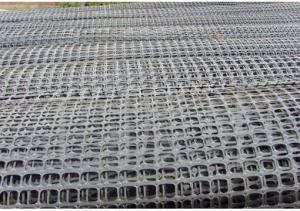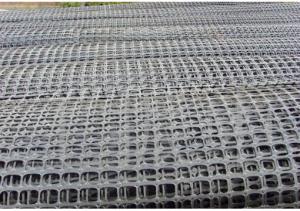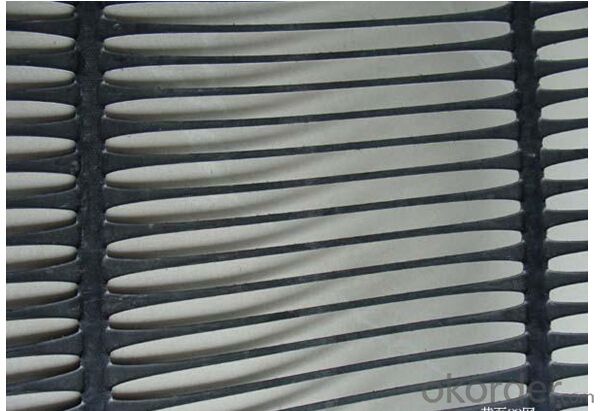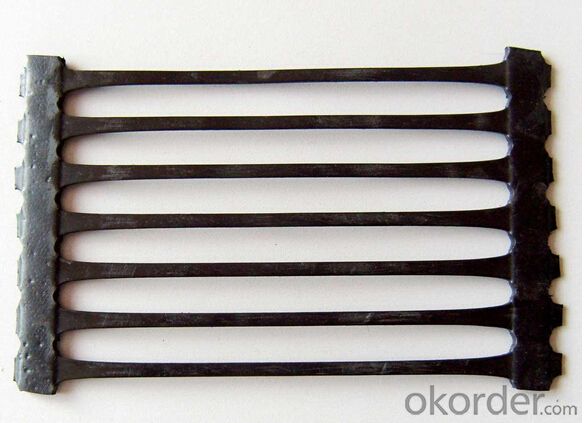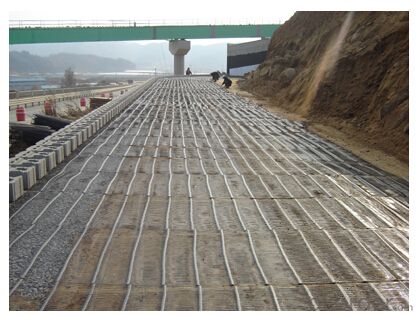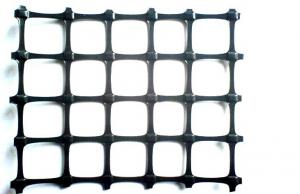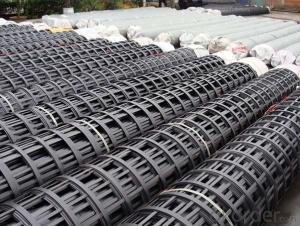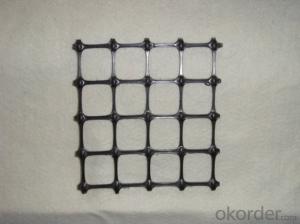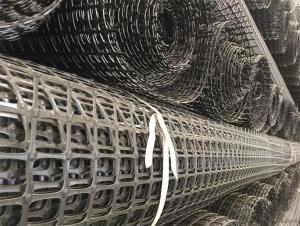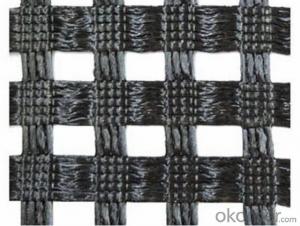Tencate Mirafi HDPE Uniaxial Geogrids with High Tensile Strength for Retaining Wall/Road Construction
- Loading Port:
- China Main Port
- Payment Terms:
- TT or LC
- Min Order Qty:
- 5000 Square Meters m²
- Supply Capability:
- 12000 Square Meters Per Week m²/month
OKorder Service Pledge
OKorder Financial Service
You Might Also Like
HDPE Uniaxial Geogrid with High Tensile Strength for Retaining Wall/Road Consturction
1. Main Introduction of HDPE Uniaxial Geogrid with High Tensile Strength for Retaining Wall/Road Consturction
In grade separation applications, Uniaxial Geogrids are used to help soils stand at virtually any desired angle; from 0 to 90 degrees. Geogrids can be combined with a wide variety of facing elements in retaining wall and slope applications to produce the desired structural or aesthetic conditions for any project.
Geogrid Reinforced Soil Retaining Walls:
Geogrid reinforced soil retaining walls offer economical and aesthetically pleasing alternatives to conventional retaining wall systems. The geogrid reinforced fill zone behind the wall facing acts as a uniform mass or block, providing stability to the wall and structure. Geogrids work with a wide variety of fill materials and facing elements including segmental concrete blocks, concrete panels, geogrid wraps, timbers or boulders.
Geogrid Reinforced Slopes:
Geogrid reinforced slopes provide a natural and economical alternative to conventional concrete retaining walls. Geogrid reinforced slopes create naturally finished slope structures that are easy to construct and enhance property values because of their natural beauty. Geogrid reinforced slopes can be built at any angle to provide the most economical use of available space while avoiding the increased cost of vertical structures.
The construction of embankments, bridge approach fills, dikes and causeways over soft soils and wetlands traditionally involves expensive, time consuming construction methods. Geogrid reinforcement of these structures minimizes the project footprint, fill requirements and differential settlement, saving time and money
2. Specifications and Technical Data of HDPE Uniaxial Geogrid with High Tensile Strength for Retaining Wall/Road Consturction
No. | Index properties | Test Method | Item(PEUG) | ||||||
60 | 80 | 120 | 160 | 180 | 200 | ||||
1 | Polymer | _ | HDPE | ||||||
2 | Minimum Carbon Black % | ASTM D4218 | 2 | ||||||
3 | Tensile Strength @ 2% Strain MD kN/m | ASTM D6637 | 16 | 23 | 35 | 47 | 52 | 58 | |
4 | Tensile Strength @ 5% Strain MD kN/m | 31 | 44 | 65 | 85 | 104 | 116 | ||
5 | Ultimate Tensile Strength MD kN/m | 60 | 80 | 120 | 160 | 180 | 200 | ||
6 | Strain @ Ultimate Strength % | 11.5 | 11.5 | 11.5 | 11.5 | 11.5 | 11.5 | ||
7 | Junction Efficiency % | GRI GG2-87 | 93 | 93 | 93 | 93 | 90 | 90 | |
8 | Flexural Rigidity mg-cm | ASTM D1388 | 1,400,000 | 2,300,000 | 7,700,000 | 19,000,000 | _ | _ | |
Durability | |||||||||
9 | UV Resistance % | ASTM D4355 | 98 | 98 | 98 | 98 | 98 | 98 | |
10 | Oxidation Resistance % | EN ISO 13438 | 100 | 100 | 100 | 100 | 100 | 100 | |
11 | Brittleness | WashDOT T926 | Pass | Pass | Pass | Pass | Pass | Pass | |
Reduction Factor | |||||||||
12 | Minimum Reduction Factor for | ASTM D5262 | 1 | _ | 1.02 | 1 | _ | _ | |
13 | Reduction Factor for Creep for | ASTM D5818 | 2.23 | 2.23 | 2.23 | 2.23 | 2.23 | 2.23 | |
Dimensions | |||||||||
14 | Roll Width m | _ | 1 | 1 | 1 | 1 | 1 | 1 | |
15 | Roll Length m | _ | 75 | 50 | 30 | 30 | 30 | 30 | |
16 | Roll Weight kg | _ | 30 | 27 | 23 | 29 | 33 | 36 | |
3. Some Photos of HDPE Uniaxial Geogrid with High Tensile Strength for Retaining Wall/Road Consturction
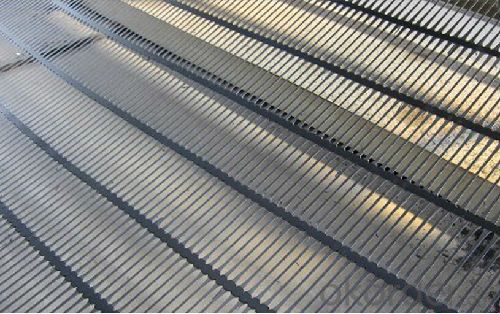
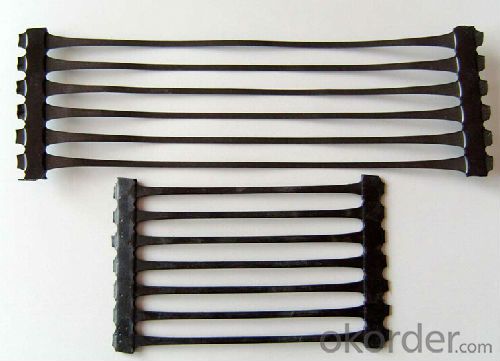
FAQ:
1. What's your payment terms?
T/T, L/C at sight
2. What's your delivery time?
Within 15days against deposit received
3/ What's your package?
WOVEN BAGS
- Q: Can geogrids be used in subgrade improvement?
- Yes, geogrids can be used in subgrade improvement. Geogrids are commonly used to reinforce weak or unstable soil in subgrade applications. They provide additional strength and stability to the soil, allowing for better load distribution and reducing settlement.
- Q: What is the 110 type bidirectional geogrid?
- As the polymer in the manufacture of plastic polymer in the process of heating with the extension of the process of re orientation, strengthen the link between the molecular chain force, to achieve the purpose of improving its strength. Its elongation rate is only 10% ~ ~ of the original plate of 15%. If the carbon black and other anti-aging materials are added in the geogrid, the utility model has the advantages of good acid resistance, alkali resistance, corrosion resistance, aging resistance and the like
- Q: How do geogrids help in reducing maintenance costs?
- Geogrids help in reducing maintenance costs by providing reinforcement to soil structures, such as retaining walls or roadways, which helps them withstand heavy loads and prevent soil erosion. This reduces the need for frequent repairs or replacements, leading to cost savings in the long run. Additionally, geogrids improve the overall stability and longevity of the structure, minimizing the need for ongoing maintenance and maintenance-related expenses.
- Q: Do geogrids provide reinforcement to geosynthetic clay liners in landfill caps?
- Yes, geogrids can provide reinforcement to geosynthetic clay liners in landfill caps. Geogrids are commonly used to enhance the stability and load-bearing capacity of geosynthetic clay liners by providing additional tensile strength and preventing lateral displacement of the clay liner. This reinforcement helps to improve the overall performance and longevity of landfill caps.
- Q: How do geogrids help in reducing soil settlement?
- Geogrids help in reducing soil settlement by providing reinforcement to the soil, increasing its stability and preventing excessive movement. They distribute the load over a larger area, improving the overall bearing capacity of the soil and reducing the potential for settlement. Additionally, geogrids can restrict lateral movement of the soil particles, minimizing the chances of settlement and maintaining the integrity of the structure or foundation.
- Q: Can geogrids be used in retaining wall drainage systems?
- Yes, geogrids can be used in retaining wall drainage systems. Geogrids are commonly used to provide additional stability and reinforcement to retaining walls. They help to distribute the load and prevent soil erosion behind the wall. Additionally, geogrids can enhance the drainage system by allowing water to flow through them, preventing the buildup of hydrostatic pressure behind the wall. This helps to maintain the structural integrity of the retaining wall and prevent any potential damage.
- Q: Are geogrids suitable for use in soil reinforcement for coastal protection structures?
- Yes, geogrids are suitable for use in soil reinforcement for coastal protection structures. Geogrids are commonly used in such applications as they provide excellent reinforcement to the soil, improving its stability and resistance against erosion caused by waves and tides. They offer high tensile strength, durability, and resistance to harsh environmental conditions. Additionally, geogrids can be easily installed and integrated into various coastal protection systems, making them an effective solution for reinforcing soil in coastal areas.
- Q: What is the meaning of the highway geogrid gsl50/hdpe
- 150 refers to the tensile strength is 150KN, it is impossible to two-way tensile plastic geogrid, plastic composite geogrid material is HDPE material,
- Q: Want to know what is the advantage of unidirectional polyester geogrid and two-way existence? What are the differences between the two?For example, function, cost, construction
- First talk to the function of it, compared with the similar functions, There are both advantages and disadvantages., but the cost of bidirectional geogrid is more expensive! Construction is the same! The difference lies in the cost! Thank you
- Q: Are geogrids effective in preventing soil erosion on slopes without vegetation?
- Yes, geogrids are effective in preventing soil erosion on slopes without vegetation. Geogrids provide reinforcement to the soil, increasing its stability and preventing it from being washed away by water or eroded by wind. They act as a barrier, retaining the soil in place and reducing the risk of erosion, even in the absence of vegetation.
1. Manufacturer Overview
| Location | 示范:Hebei, China |
| Year Established | 示范:1997 |
| Annual Output Value | 示范:Above US$50 Million |
| Main Markets | 30.00% South America; 20.00% North America; 15.00% Eastern Europe; 15.00% Southeast Asia; 10.00% South Asia; 5.00% Southern Europe; 5.00% Africa |
| Company Certifications | ISO 9001:2008 |
2. Manufacturer Certificates
| a) Certification Name | |
| Range | |
| Reference | |
| Validity Period |
3. Manufacturer Capability
| a) Trade Capacity | |
| Nearest Port | Tianjin;Qingdao;Shanghai |
| Export Percentage | |
| No.of Employees in Trade Department | 21-50 People |
| Language Spoken: | English;Chinese |
| b) Factory Information | |
| Factory Size: | Above 100,000 square meters |
| No. of Production Lines | Above 12 |
| Contract Manufacturing | OEM Service Offered;Design Service Offered |
| Product Price Range | High;Average |
Send your message to us
Tencate Mirafi HDPE Uniaxial Geogrids with High Tensile Strength for Retaining Wall/Road Construction
- Loading Port:
- China Main Port
- Payment Terms:
- TT or LC
- Min Order Qty:
- 5000 Square Meters m²
- Supply Capability:
- 12000 Square Meters Per Week m²/month
OKorder Service Pledge
OKorder Financial Service
Similar products
Hot products
Hot Searches
Related keywords
